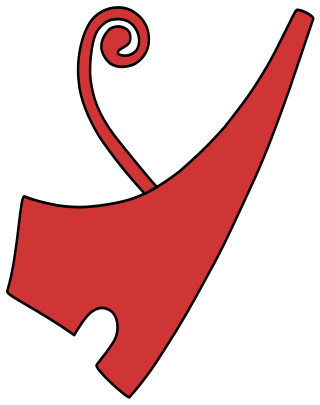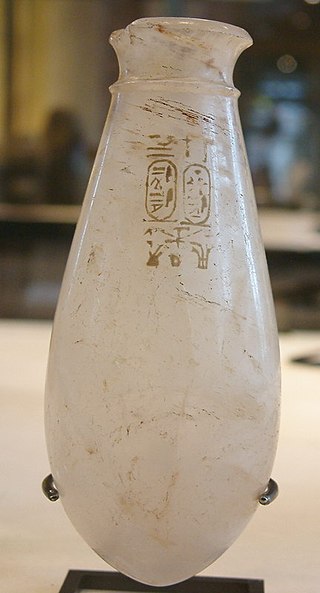Shishak, also spelled Shishaq or Susac, was, according to the Hebrew Bible, an Egyptian pharaoh who sacked Jerusalem in the 10th century BCE. He is usually identified with the pharaoh Shoshenq I.

Deshret was the Red Crown of Lower Egypt. When combined with the Hedjet of Upper Egypt, it forms the Pschent, in ancient Egyptian called the sekhemti.
The ancient Egyptian Harpoon,, is one of the oldest language hieroglyphs from ancient Egypt. It is used on the famous Narmer Palette of Pharaoh Narmer from the 31st century BC, in an archaic hieroglyphic form.

The ancient Egyptian Mast hieroglyph is one of the oldest language hieroglyphs from Ancient Egypt. It is used on a famous label of Pharaoh Den of the First dynasty, but forms part of the location hieroglyph: Emblem of the East.
The Walking Legs-forward is an ancient Egyptian language hieroglyph of the concept of action, part of "going and returning". Walking Legs-returning is the other half.
In ancient Egyptian hieroglyphs, the hand symbol represented the phoneme /d/, and was also used as a determinative for actions performed as if with the hands.
The ancient Egyptian Dua hieroglyph is one of a series of language and visual hieroglyphs used from the earliest dynasties of Ancient Egypt, and that portrays men, women, ideology, and some occupations.
The Foreleg of ox hieroglyph of ancient Egypt is an old hieroglyph; it even represented a nighttime constellation. It came to have many uses in ancient Egypt over three millennia.
The Throw stick hieroglyph of ancient Egypt is an old hieroglyph that dates from the Predynastic Period; it is from the assemblage of hieroglyphs used on the ornamental, or ceremonial cosmetic palettes. It is used on the palettes both as a throwing-stick weapon in the animal hunt being portrayed-(the Hunters Palette), as well as on certain palettes, as a determinative referring to a "foreigner", or "foreign territory".

The Battlefield Palette may be the earliest battle scene representation of the dozen or more ceremonial or ornamental cosmetic palettes of ancient Egypt. Along with the others in this series of palettes, including the Narmer Palette, it includes some of the first representations of the figures, or glyphs, that became Egyptian hieroglyphs. Most notable on the Battlefield Palette is the standard, and Man-prisoner hieroglyph, probably the forerunner that gave rise to the concept of the Nine bows.
The ancient Egyptian Papyrus stem hieroglyph is one of the oldest language hieroglyphs from Ancient Egypt. The papyrus stalk, was incorporated into designs of columns on buildings, also facades, and is also in the iconographic art portrayed in ancient Egyptian decorated scenes.

The ancient Egyptian Bowstring hieroglyph is an Egyptian language hieroglyph associated with the bow, and its use as a hieroglyph for the Archer hieroglyph, a symbol for 'army'. Because of the strength required to "string a bow", with a bow string, the bowstring hieroglyph is used to define words of strength, hardness, durability, etc.

The ancient Egyptian Hill-country or "Foreign land" hieroglyph (𓈉) is a member of the sky, earth, and water hieroglyphs. A form of the hieroglyph in color, has a green line-(banding) at the base of the hieroglyph. The hieroglyph refers to the hills, and mountains, on both sides of the Nile River, and thus the green references the verdant black farming land adjacent to the river proper. It is coded N25 in Gardiner's sign list, and U+13209 in Unicode. It is a determinative hieroglyph, simply conveying a meaning, and has no phonetic value.
The pectorals of ancient Egypt were a form of jewelry, often represented as a brooch. These were mostly worn by richer people and the pharaoh.

The Egyptian hieroglyph representing gold, phonetic value nb, is important due to its use in the Horus-of-Gold name, one of the Fivefold Titulary names of the Egyptian pharaoh.
The ancient Egyptian Branch hieroglyph, also called a Stick, is a member of the trees and plants hieroglyphs.

The ancient Egyptian Bone-with-meat hieroglyph represented: "ancestry, inherit", and phonetic isw, iw' ; a determinative for the femur, (iw'); and swt, for the tibia.

The Egyptian hieroglyph Townsite-city-region is Gardiner sign listed no. O49 for the intersection of a town's streets. In some Egyptian hieroglyph books it is called a city plan.
The ancient Egyptian Grape arbor hieroglyph is Gardiner sign listed no. M43 in Gardiner's subcategory for trees and plants. The hieroglyph shows a horizontal vine with stylized bunches suspended below; each end is supported by the hieroglyph for a "prop", Gardiner no. O30,
This page list topics related to ancient Egypt.















